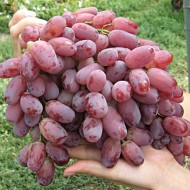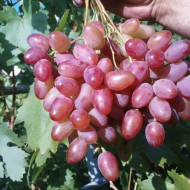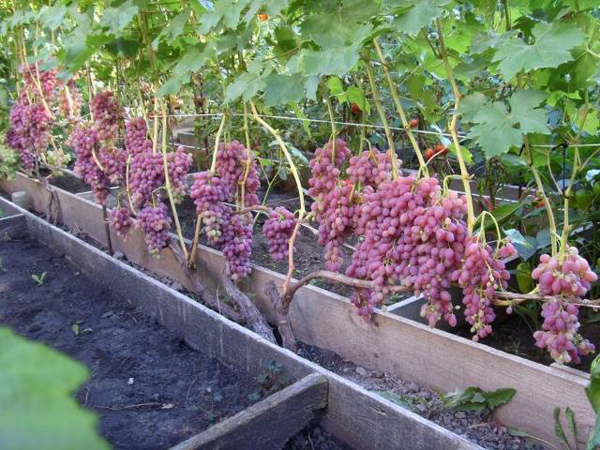We grow the popular early ripening grape variety Transfiguration
Content
Breeding history
Grape Transfiguration is not recorded in the State Register of Breeding Achievements of Russia. Despite the lack of recognition at the state level, the fruit and berry culture is very popular among farmers.
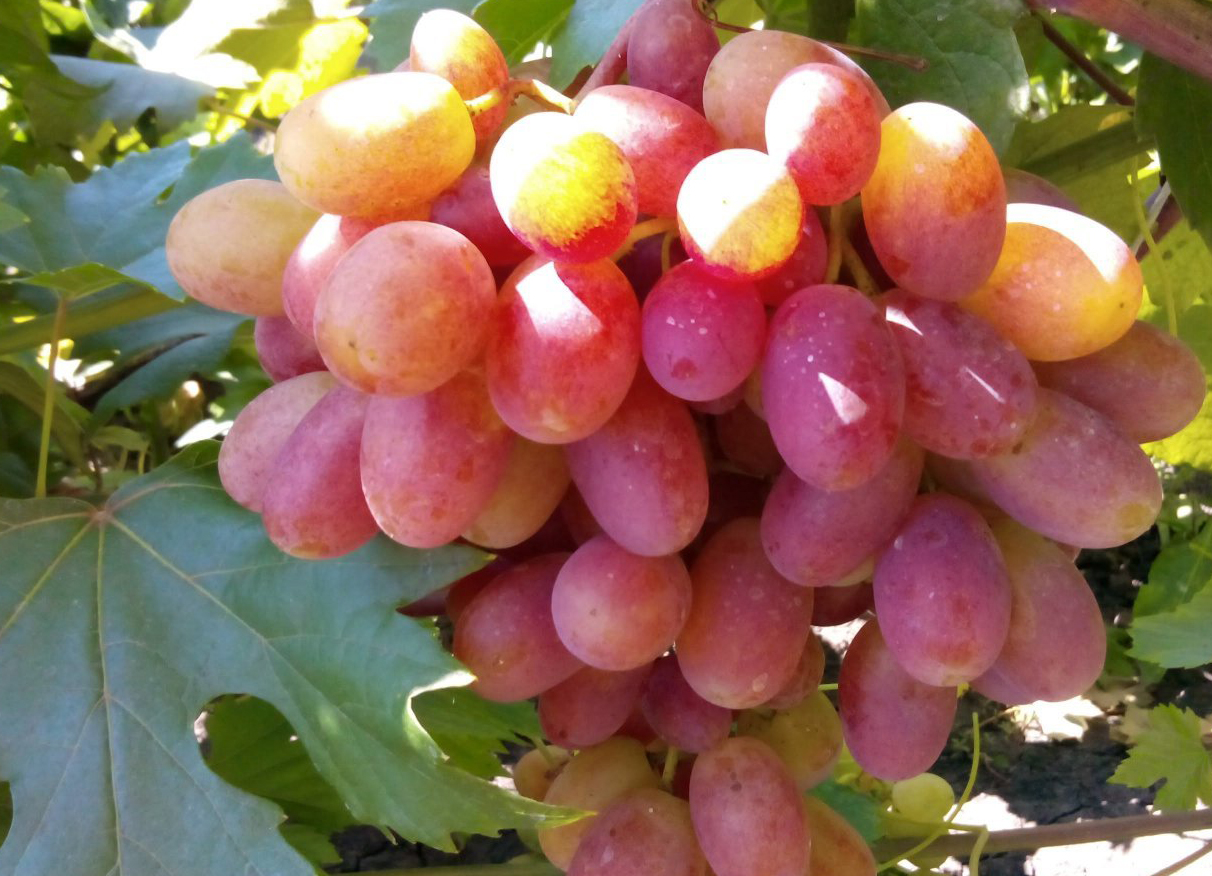
A distinctive feature of Transfiguration grapes - large berries
The author of the interspecific hybrid is Viktor Nikolaevich Krainov, an amateur breeder from Novocherkassk. The gardener's brainchilds are three hybrid forms: grapes Victor, Transfiguration and Anniversary of Novocherkassk. All three crops, which are popularly called the "Krainov Troika", are characterized by intense fruiting and increased productivity.
The progenitors of the Transfiguration grapes were the Talisman and Radiant Kishmish varieties. The interspecific hybrid took over all the positive features from the parent crops: early fruiting, high yield, unpretentiousness to growing conditions and care, amazing taste and excellent commercial qualities.
- Transformation
- Victor
- Anniversary of Novocherkassk
Video "Acquaintance with grapes Transformation"
This video provides a detailed botanical description of a relatively young fruit and berry crop.
Description
Grape Transfiguration refers to tall fruit and berry crops. The plant is prone to abundant stepson formation. Self-pollinated flowers.
The bunches are large, weighty, conical or cylindrical in shape. The weight of one grape cluster varies from 1 to 3 kg. At the same time, the average weight of one grape is 20 g. The shape of the berry is elongated-oval. The skin has a beautiful pink-purple color with a slight bluish bloom. The skin is thin but very firm.
The berry taste is harmonious, slightly cooling, pleasantly sweet with a slight sourness. The pulp is juicy and aromatic.
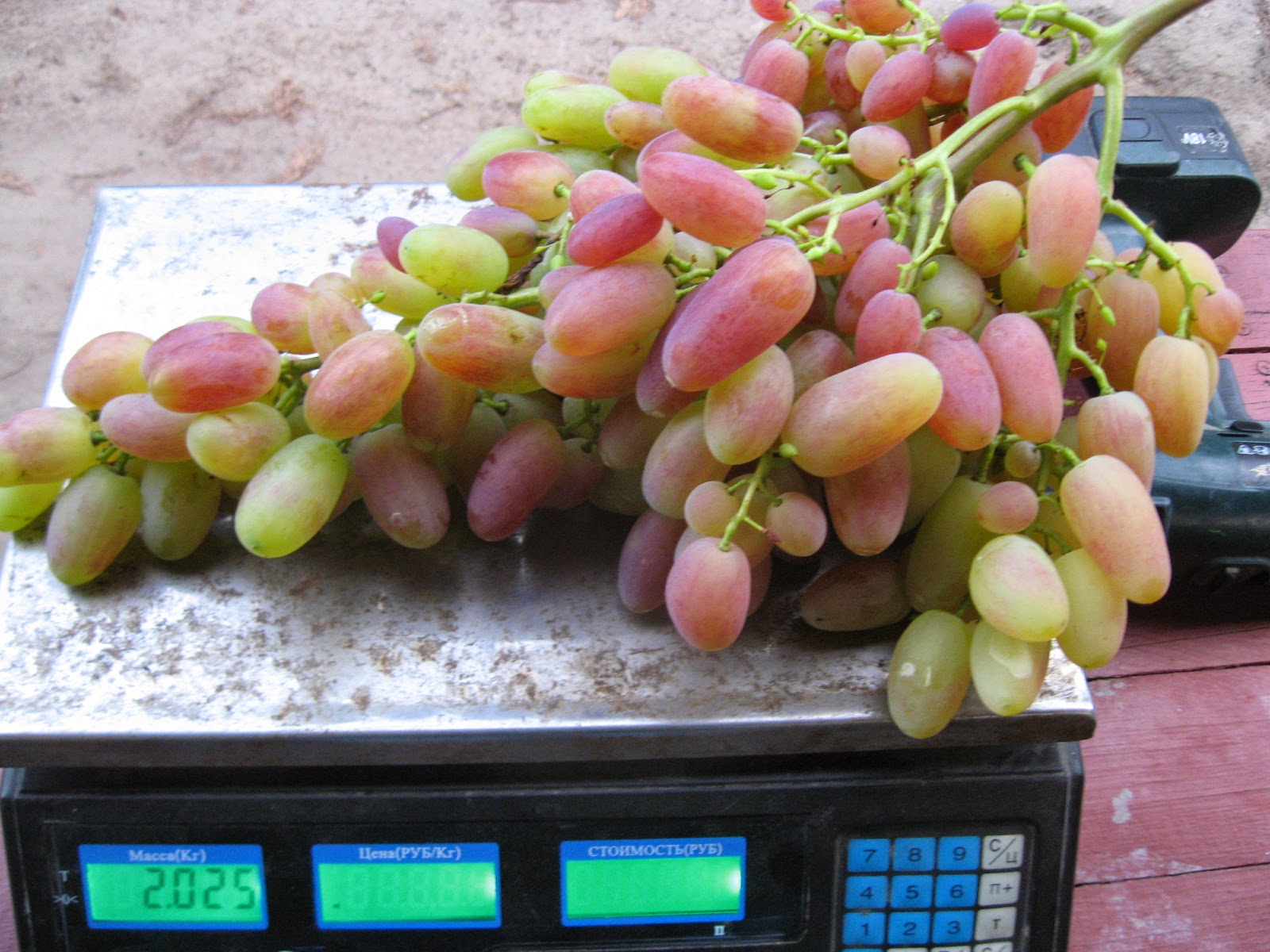
The average weight of one bunch is 2 kg
- excellent productivity;
- abundant and early fruiting;
- self-pollination;
- lack of peeling and cracking of fruits;
- good transportability;
- long period of storage of the crop;
- universality of culture;
- high decorative qualities of the bush;
- large-fruited;
- excellent taste and market characteristics;
- undemanding care.
- intensive stepson formation;
- tendency to fungal and bacterial infections;
- dubious frost resistance.
In which regions is it better to grow
The interspecific hybrid is distinguished by its rapid adaptability to various growing conditions and unpretentious care. Due to its high drought and frost resistance, the crop can be grown even in central Russia and in the northern regions.But do not forget that temperature drops and severe frosts can cause shrubs to freeze out. Proper preparation and shelter of shrubs for the winter will help prevent the death of the vineyard.
The optimal climate for growing grapes Transformation is the territory of Ukraine, Belarus and the southern regions of the Russian Federation.
Variety characteristics
The choice of any fruit and berry crop depends on its technical characteristics. Let us consider in more detail what is remarkable about the interspecific hybrid of grapes Transfiguration.
Productivity and ripening time
Grape Transfiguration refers to early ripening fruit and berry crops. The ripening period lasts 110-115 days. Under favorable weather conditions, the ripening period may be slightly reduced.
The first harvest begins in the last decade of July. You can determine the degree of ripeness of berries by their appearance. The berries that have reached removable maturity have a dense and slightly shiny skin. When pressed lightly, the fruits are slightly squeezed, but not cracked.
The average yield per adult bush is 20-25 kg. With plenty of sunshine and moderate watering, yields can be 5–10% higher.
Fruit application
A distinctive feature of the fruit and berry crop is good transportability over long distances and a long shelf life. Berries do not lose their taste and marketability.
The Transfiguration grape is a table variety. Juicy ripe fruits can be eaten fresh, as well as used to prepare salads, snacks and desserts. With amazing taste and aroma, the fruits are used to make wines and raisins.
Drought and frost resistant
In the botanical portrait of the culture, it is noted that shrubs easily adapt to climatic changes and endure a drop in air temperature to -23 ° C. However, according to the reviews of winegrowers and gardeners, the lowest air temperature for the Transfiguration grapes is -18 ° C. If the weather forecast says that severe frosts are coming, take care of the shelter of the vineyard.
Drought resistance of the culture is average, the plant loves moderate watering. Grapes react negatively to both lack of moisture and its excess.
Planting grapes Transfiguration
The yield of fruit crops depends on the observance of agricultural cultivation techniques. For example, planting hybrid seedlings. Transformation into open ground is best in mid-spring. By this time, the soil will have time to warm up well. The root system of a young seedling will not suffer from possible late frosts on the ground.
Spring planting provides an opportunity for a young culture to take root and take root in a new growing area. By the first autumn or winter frosts, the grape shrubs have time to get stronger.
Selection of cuttings
A well-chosen seedling is a guarantee of a stable and abundant harvest. So the plant should look healthy. At the same time, there should be no signs of rotting or frostbite on it, and there are no traces of parasitic individuals and typical infections.
The root system is well developed. Young root shoots are whitish-brown. The cross-sectional color of the cutting is deep green. If dark spots are noticeable on the cut, it is better to refuse such planting material. The plant can be infected with bacterial or fungal diseases characteristic of grape crops.
Site selection and preparation
The next stage is the selection and preparation of a place for planting a seedling. The grapes love abundant sunlight. Neighborhood with tall trees and shrubs is undesirable. Excess shade leads to a deterioration in fruiting and frequent diseases of the fruit and berry culture.
The best option for a landing site is the south side of the personal plot. The area should be closed from piercing winds and drafts. The groundwater level is not higher than 1.5 m from the earth's surface. Excess moisture in the soil is detrimental to the vineyard. For this reason, it is not recommended to plant seedlings in lowlands, where melt and rainwater often collects.

Landing
Planting a grape seedling is carried out according to the standard scheme:
- Soaking the root system of the bush in water for 24 hours. Subsequent treatment of the root with growth biostimulants.
- Preparation of a planting pit with a depth of at least 50–70 cm. The distance between the holes ranges from 1 to 2 m.
- The bottom of the planting pit is laid out with organic fertilizers. On top of organics, a hill is formed from the earth.
- The seedling is deepened into the soil so that the root collar remains above the ground. There should be at least 3-4 cm from the edge of the root collar to the soil surface.
- Sprinkle the young seedling with the remaining soil. Gently tamp the soil, water abundantly and mulch the near-trunk circle.

Planting grape seedling
Care features
Interspecific hybrid Transformation is considered an unpretentious fruit and berry crop.
Care during vegetation and fruiting
During the period of ovary formation and fruiting, you need to monitor the level of moisture, timely fertilize and periodically loosen the soil. Removing weeds and loosening the soil contributes to the saturation of the soil with oxygen and nutrients.
Watering
Hybrid form Transfiguration loves moderate watering. Lack of moisture leads to premature wilting of the shrub, excess - to rotting of the root collar. Young shrubs are watered once every 7 days, "old" ones - 1-2 times a month. The frequency of watering is determined by the climatic features of the region and the amount of precipitation. One grape bush requires 20 to 40 liters of settled water.
Fertilizer
You can feed the fruit and berry culture with organic matter (wood ash, bird droppings, peat, humus and rotted manure) and complex mineral fertilizers.

Table: terms and rules for fertilization
In the spring, when the plant wakes up, nitrogen-containing preparations are introduced, which contribute to the active growth of green mass. In summer and autumn, the vineyards are fed with potassium-phosphorus fertilizers with a high copper content. Complex mineral supplements increase the frost resistance of fruit bushes.
Pruning
In the spring months, the formative pruning of the shrub falls. On each plant, about 20-28 healthy and well-developed shoots are left. The procedure is recommended to be performed before the formation of the kidneys.
Sanitary pruning is done in the fall. All old branches damaged by insects and injured by winds are subject to removal.
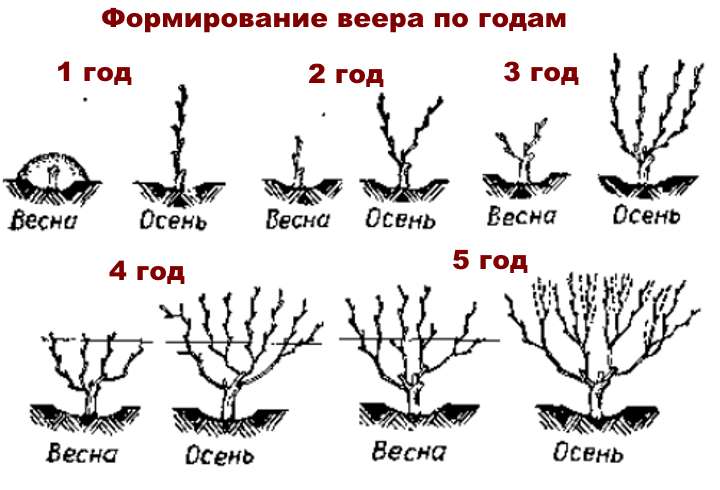
Fan pruning of a grape bush
Pest and disease control
According to gardeners, the Transformation suffers from invasions of harmful insects. On fruit and berry crops, there are grape moth, cushion, leafworm, spider mite, thrips, aphids and other parasites. You can fight uninvited guests with soapy water, garlic water and diluted 4% iron sulfate.
Insecticidal preparations "Fitoverm", "Calypso" and "Intra-vir" will help to quickly and effectively get rid of parasites.
Unfortunately, the interspecific hybrid is characterized by poor resistance to various fungal and bacterial ailments. Diseases such as bacterial cancer, mildew, mildew, and spotted necrosis are characteristic of the grape bush. To protect the garden culture, fungicidal agents "Topaz", "Horus", "Ridomil", "Vitaros" and others are used.
The above rules for caring for the plant will help prevent the development of diseases and the invasion of insects.
Preparing culture for winter
For the winter, the grapes are covered.Shoots must be collected in bunches, bent to the ground and fixed with metal brackets or slate. A generous covering layer should be formed over the vine. This can be pine spruce branches, scorched foliage, dry river sand, sawdust, hay, straw, or non-woven covering material that is breathable.
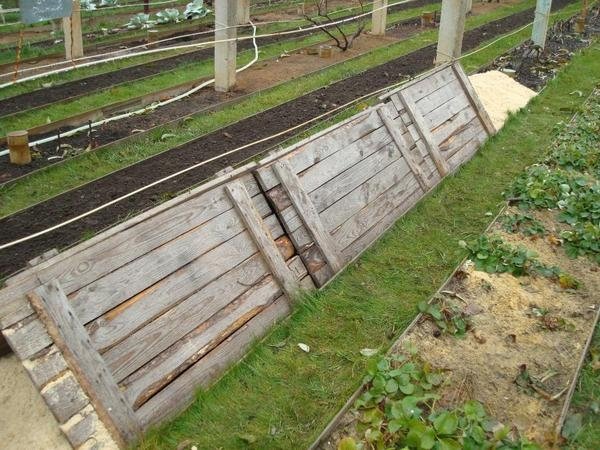
For the winter, grape bushes cover
Propagation of grapes
Propagation of Preobrazhensky grapes can be done by seedlings and by grafting cuttings. We already know how to plant seedlings in open ground. Now let's take a closer look at the method of grafting cuttings.
Cuttings are cut in spring or autumn. Each stalk has 2-3 eyes. In this case, the minimum distance to the first eye is 3-5 mm. On the eve of vaccination, the stalk is immersed in warm water with a growth biostimulator. If the grafting falls in the fall, it is necessary to increase the frost resistance of the scion. The stalk is dipped for 1-2 seconds in hot paraffin, then in cool water.
A T-shaped incision is made on the stock. The prepared stalk is inserted into the formed incision, the bark is sealed and the grafting site is tied with dense matter. The junction of the rootstock and the scion can be treated with garden varnish. The fixing bandage is removed with the appearance of the first leaves on the scion.
Grapes Transformation is the dream of every winegrower and gardener. With minimal care, the fruit and berry culture gives a bountiful harvest of tasty and aromatic grapes. The harvested fruits can be eaten fresh, processed or even sold.


